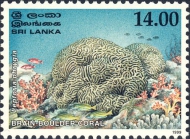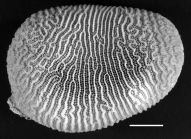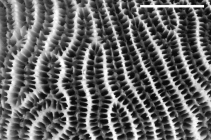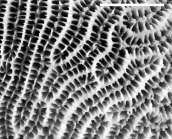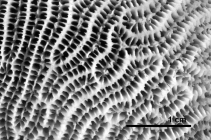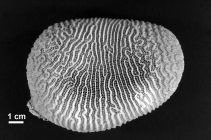
Scleractinia taxon detailsLeptoria phrygia (Ellis & Solander, 1786)
207477 (urn:lsid:marinespecies.org:taxname:207477)
accepted
Species
Leptoria gracilis (Dana, 1846) · unaccepted > junior subjective synonym
Leptoria phrygia var. gracilis (Dana, 1846) · unaccepted > junior subjective synonym
Leptoria tenuis (Dana, 1846) · unaccepted > junior subjective synonym
Madrepora phrygia Ellis & Solander, 1786 · unaccepted > superseded combination (basionym)
Maeandra (Platygyra) phrygia (Ellis & Solander, 1786) · unaccepted > superseded combination
Maeandra gracilis (Dana, 1846) · unaccepted > junior subjective synonym
Maeandra tenuis (Dana, 1846) · unaccepted > junior subjective synonym
Maeandrina gracilis Dana, 1846 · unaccepted > junior subjective synonym
Maeandrina phrygia (Ellis & Solander, 1786) · unaccepted > superseded combination
Maeandrina tenuis Dana, 1846 · unaccepted > junior subjective synonym
Meandrina gracilis Dana, 1846 · unaccepted > junior subjective synonym
Meandrina phrygia (Ellis & Solander, 1786) · unaccepted > superseded combination
Meandrina tenuis Dana, 1846 · unaccepted > junior subjective synonym
Platygyra gracilis (Dana, 1846) · unaccepted > junior subjective synonym
Platygyra phrygia (Ellis & Solander, 1786) · unaccepted > superseded combination
marine,
recent + fossil
(of Madrepora phrygia Ellis & Solander, 1786) Ellis, J.; Solander, D. (1786). The Natural History of many curious and uncommon Zoophytes, collected from various parts of the Globe. Systematically arranged and described by the late Daniel Solander. 4.(Benjamin White & Son: London): 1-206, pls 1-63., available online at https://www.biodiversitylibrary.org/page/41943909 [details]
Holotype (of Madrepora phrygia Ellis & Solander, 1786)...
Holotype (of Madrepora phrygia Ellis & Solander, 1786) GLAHM [details]
Description Valleys are particularly long, often winding but with extensive straight sections. Valleys are usually narrower than those...
Description Valleys are particularly long, often winding but with extensive straight sections. Valleys are usually narrower than those of the meandroid Platygyra species. Its columella is a laminar ribbon, or is a thick keel with vertical undulations. This separates it from Platygyra. The range of valley, wall and septa widths is considerable, and is greater than the span encompassed by the two meandroid Playtgyra species but despite this it is now generally considered to be a single variable species. The species is largely restricted to water less than about 6 m deep. It occurs principally on exposed and moderately exposed reef crests and seaward facing reef slopes, or on deeper patches of reef flats subjected to good water exchange. Within this shallow, fairly turbulent habitat it is abundant and a consistent component. It is always grey in colour. (Sheppard, 1998 <308>) Colonies are massive with an even surface and dense skeleton. Corallite valleys are highly meandroid and very uniform. Septa are uniformly spaced and are of equal size. Columellae are wall-like with lobed upper margin and do not form centres. Paliform lobes are absent. Polyps are extended only at night. Colour: cream, brown or green, with walls and valleys of different colours. Abundance: occurs in most reef environments except where the water is turbid. Often common in upper reef slopes. (Veron, 1986 <57>) Forms irregularly humped, massive colonies with meandering surface pattern of corallites very similar to Platygyra and Oulophyllia but with more pronounced ribs on the walls. Colour: walls of corallites are brown with green or cream valleys. Habitat: in lagoons and on clear water reef slopes. (Richmond, 1997) [details]
Hoeksema, B. W.; Cairns, S. (2025). World List of Scleractinia. Leptoria phrygia (Ellis & Solander, 1786). Accessed at: https://www.marinespecies.org/scleractinia/aphia.php?p=taxdetails&id=207477 on 2025-05-04
Date action by
original description
(of Madrepora phrygia Ellis & Solander, 1786) Ellis, J.; Solander, D. (1786). The Natural History of many curious and uncommon Zoophytes, collected from various parts of the Globe. Systematically arranged and described by the late Daniel Solander. 4.(Benjamin White & Son: London): 1-206, pls 1-63., available online at https://www.biodiversitylibrary.org/page/41943909 [details]
original description (of Meandrina tenuis Dana, 1846) Dana, J.D. (1846-1849). Zoophytes. United States Exploring Expedition during the years 1838-1842. <em>Lea and Blanchard, Philadelphia.</em> 7: 1-740, 61 pls. (1846: 1-120, 709-720; 1848: 121-708, 721-740; 1849: atlas pls. 1-61)., available online at https://www.biodiversitylibrary.org/page/18989497, http://www.sil.si.edu/digitalcollections/usexex/navigation/ScientificText/USExEx19_08select.cfm [details] original description (of Meandrina gracilis Dana, 1846) Dana, J.D. (1846-1849). Zoophytes. United States Exploring Expedition during the years 1838-1842. <em>Lea and Blanchard, Philadelphia.</em> 7: 1-740, 61 pls. (1846: 1-120, 709-720; 1848: 121-708, 721-740; 1849: atlas pls. 1-61)., available online at https://www.biodiversitylibrary.org/page/18989497, http://www.sil.si.edu/digitalcollections/usexex/navigation/ScientificText/USExEx19_08select.cfm [details] context source (Hexacorallia) Fautin, Daphne G. (2013). Hexacorallians of the World. (look up in IMIS) [details] basis of record Veron JEN. (1986). Corals of Australia and the Indo-Pacific. <em>Angus & Robertson Publishers.</em> [details] additional source Veron JEN, Pichon M, Wijsman-Best M. (1977). Scleractinia of Eastern Australia – Part II. Families Faviidae, Trachyphylliidae. <em>Australian Institute of Marine Science Monograph series.</em> 3: 1-233. [details] additional source Dunn, D.F., 1970. Some observations on marine life at Pulau Aur, Johore. Malay. Nat. J. 23 : 158-167. page(s): 162 [details] additional source Dawson EW. (1992). The Coelenterata of the New Zealand region: a handlist for curators, students and ecologists. <em>Occasional papers of the Hutton Foundation, New Zealand.</em> 1: 1-68. page(s): 48 [details] additional source Hoffmeister, J.E. (1925). Some corals from America Samoa and the Fiji Islands. <em>Papers from the Department of Marine Biology of the Carnegie Institution of Washington.</em> 22: 1-90, pls. 1-23. page(s): 6, 7, 8, 11, 12, 27-28, Pl. 2, figs. 1a, 1b [details] additional source Vaughan TW. (1918). Some shallow-water corals from Murray Island (Australia), Cocos-Keeling Island, and Fanning Island. <em>Papers from the Department of Marine Biology of the Carnegie Institution of Washington.</em> 9 (213): 49-234, pls. 20-93. [details] additional source Cairns, S.D., B.W. Hoeksema & J. van der Land. (1999). Appendix: List of extant stony corals. <em>Atoll Research Bulletin.</em> 459: 13-46. page(s): 29 [details] additional source Randall RH. (2003). An annotated checklist of hydrozoan and scleractinian corals collected from Guam and other Mariana Islands. <em>Micronesica.</em> 35-36: 121-137. page(s): 133 [details] additional source Cairns, S.D., B.W. Hoeksema & J. van der Land. (2007). as a contribution to UNESCO-IOC Register of Marine Organisms. (look up in IMIS) [details] additional source Liu, J.Y. [Ruiyu] (ed.). (2008). Checklist of marine biota of China seas. <em>China Science Press.</em> 1267 pp. (look up in IMIS) [details] Available for editors additional source Veron JEN. (2000). Corals of the World. Vol. 1–3. <em>Australian Institute of Marine Science and CRR, Queensland, Australia.</em> [details] additional source Scheer G, Pillai CSG. (1974). Report on Scleractinia from the Nicobar Islands. <em>Zoologica, Stuttgart.</em> 42(122): 1-75. page(s): 9, 52, 75 [details] additional source Nemenzo, F. (1971). Systematic studies on Philippine shallow-water scleractinians: VII. Additional forms. <em>Natural and Applied Science Bulletin, University of the Philippines.</em> 23: 141-209. page(s): 143, 166 [details] additional source Yabe H, Sugiyama T. (1935). Revised list of the reef-corals from the Japanese seas and of the fossil reef corals of the raised reefs and the Ryukyu limestone of Japan. <em>Journal of the Geological Society of Japan.</em> 42: 379-403. page(s): 384, 386, 388, 390, 391, 394 [details] additional source Cairns, S.D., L. Gershwin, F.J. Brook, P. Pugh, E.W. Dawson, O.V. Ocaña, W. Vervoort, G. Williams, J.E. Watson, D.M. Opresko, P. Schuchert, P.M. Hine, D.P. Gordon, H.I. Campbell, A.J. Wright, J.A.Sánchez & D.G. Fautin. (2009). Phylum Cnidaria: corals, medusae, hydroids, myxozoans. <em>in: Gordon, D.P. (Ed.) (2009). New Zealand inventory of biodiversity: 1. Kingdom Animalia: Radiata, Lophotrochozoa, Deuterostomia.</em> :59-101., available online at https://repository.si.edu/handle/10088/8431 [details] Available for editors additional source Pillai CSG, Scheer G (1976) Report on the stony corals from the Maldive Archipelago. Results of the Xarifa Expedition 1957/58. Zoologica, Stuttgart 43 (126): 1-83, pls. 1-32. [details] additional source Crossland C (1952) Madreporaria, Hydrocorallinae, Heliopora and Tubipora. Scientific Report Great Barrier Reef Expedition 1928-29 VI(3): 85-257. page(s): 91 [details] additional source Bassett-Smith, P.W. (1890). Report on the corals from Tizard and Macclesfield Banks, China Sea. <em>Annals and Magazine of Natural History,.</em> 6(35): 353-374, 443-458, pls. 12-14., available online at https://doi.org/10.1080/00222939008694050 page(s): 358, 370 [details] additional source Chevalier JP. (1975). Les Scléractiniaires de la Mélanésie Française (Nouvelle-Caledonie, Iles Chesterfield, Iles Loyauté, Nouvelles Hébrides). II. Expedition Française sur les Récifs Coralliens Nouv.-Calédonie. 7: 1-407, pls. 1-42. Paris. [details] additional source Wijsman-Best M (1976) Biological results of the Snellius expedition: XXVII. Faviidae collected by the Snellius Expedition. II. The genera Favites, Goniastrea, Platygyra, Oulophyllia, Leptoria, Hydnophora and Caulastrea. Zoologische Mededelingen, Leiden 50: 45-63. [details] additional source Wijsman-Best M (1972) Systematics and ecology of New Caledonian Faviinae (Coelenterata–Scleractinia). Bijdragen tot de Dierkunde 42: 3-90. [details] additional source Pichon, M.; Benzoni, F. (2007). Taxonomic re-appraisal of zooxanthellate Scleractinian Corals in the Maldive Archipelago. <em>Zootaxa.</em> 1441: 21–33. page(s): 32 [details] additional source Huang D, Benzoni F, Fukami H, Knowlton N, Smith ND, Budd AF (2014) Taxonomic classification of the reef coral families Merulinidae, Montastraeidae, and Diploastraeidae (Cnidaria: Anthozoa: Scleractinia). Zoological Journal of the Linnean Society 171: 277–355., available online at https://doi.org/10.1111/zoj.12140 [details] additional source Matthai G (1924) Report on the madreporarian corals in the collection of the Indian Museum, Calcutta. Memoirs of the Indian Museum 8: 1-59. [details] additional source Faustino LA. (1927). Recent Madreporaria of the Philippine Islands. <em>Bureau of Science Manila Monograph.</em> 22: 1-310, pls. 1-100. page(s): 13, 37, 40, 142 [details] additional source Veron JEN, Marsh LM. (1988). Hermatypic corals of Western Australia : records and annotated species list. <em>Records Western Australian Museum Supplement.</em> 29: 1-136., available online at https://doi.org/10.5962/bhl.title.60555 page(s): 30, 109 [details] additional source Pillai CSG. (1972). Stony corals of the seas around India. <em>Proceedings of the First International Symposium on Corals and Coral Reefs, 1969. Marine Biological Association of India Symposium.</em> 5: 191-216. page(s): 207 [details] additional source Boshoff, P.H. (1981). An annotated checklist of Southern Africa Scleractinia. <em>Oceanographic Research Institute Investigational Report, Durban.</em> 49: 1-45. page(s): 33 [details] additional source Randall RH, Myers RF. (1983). The corals. Guide to the Coastal Resources of Guam: Vol. 2. <em>University of Guam Press, Guam, pp. 128.</em> [details] additional source Khalil HM, Fathy MS, Al Sawy SM. (2021). Quaternary corals (Scleractinia: Merulinidae) from the Egyptian and Saudi Arabian Red Sea Coast. <em>Geological Journal.</em> , available online at https://onlinelibrary.wiley.com/doi/10.1002/gj.4145?af=R [details] additional source Veron, J. E. N. (2000). Corals of the World, Volume III: Families Mussidae, Faviidae, Trachyphylliidae, Poritidae. Australian Institute of Marine Science. Townsville., volume 3, pp. 490. page(s): 204-205 [details] additional source Maragos, J. E.; Molina, M.; Kenyon, J. (2004). Palmyra Atoll coral data compiled from Townsend Cromwell 2000-2002, U.S. Fish and Wildlife Service 2000-2001, and Sette 2004 surveys [Table 8]. UNPUBLISHED, UNPUBLISHED [details] additional source Milne Edwards, H.; Haime, J. (1849). Recherches sur les polypiers, quatrième mémoire. Monographie des astréides (1). Annales des Sciences Naturelles, 11, 3, 265-298 page(s): 292 [details] additional source Wells JW. (1954). Recent corals of the Marshall Islands: Bikini and nearby atolls, part 2, oceanography (biologic). <em>U.S. Geological Survey Professional Paper.</em> 260(I): 385-486. page(s): 394 [details] additional source Pillai CSG. (1983). Structure and generic diversity of recent Scleractinia of India. <em>Journal of the Marine Biological Association of India.</em> 25, 1-2, 78-90. page(s): 87 [details] additional source Sheppard, C. R. C. (1985). Fringing reefs in the southern region, Jeddah to Jizan. Fauna of Saudi Arabia, 7, 37-58 page(s): 45 [details] additional source Kühlmann, D. H. H. (2006). Die Steinkorallensammlung im Naturhistorischen Museum in Rudolstadt (Thüringen) nebst ökologischen Bemerkungen. Rudolstädter Naturhistorische Schriften, 13, 37-113 page(s): 44 [details] additional source Wallace, C. C.; Fellegara, I.; Muir, P. R.; Harrison, P. L. (2009). The scleractinian corals of Moreton Bay, eastern Australia: high latitude, marginal assemblages with increasing species richness. Memoirs of the Queensland Museum, 54, 2 page(s): 10 [details]  Present Present  Inaccurate Inaccurate  Introduced: alien Introduced: alien  Containing type locality Containing type locality
Holotype (of Madrepora phrygia Ellis & Solander, 1786) GLAHM [details]
Nontype (of Leptoria gracilis (Dana, 1846)) MSI U.P.C.-794, geounit Philippines Exclusive Economic Zone [details]
Nontype (of Platygyra phrygia (Ellis & Solander, 1786)) IGPS 39339, geounit Japanese Exclusive Economic Zone [details]
Nontype (of Platygyra phrygia (Ellis & Solander, 1786)) IGPS 40767, geounit Japanese Exclusive Economic Zone [details]
Nontype (of Platygyra phrygia (Ellis & Solander, 1786)) IGPS 44640, geounit Japanese Exclusive Economic Zone [details]
Nontype (of Platygyra phrygia (Ellis & Solander, 1786)) IGPS 44666, geounit Japanese Exclusive Economic Zone [details]
Nontype (of Platygyra phrygia (Ellis & Solander, 1786)) IGPS 48239, geounit Japanese Exclusive Economic Zone [details]
Nontype (of Platygyra phrygia (Ellis & Solander, 1786)) IGPS 48240, geounit Japanese Exclusive Economic Zone [details]
Nontype (of Platygyra phrygia (Ellis & Solander, 1786)) IGPS 49329, geounit Marshall Islands Exclusive Economic Zone [details]
Nontype (of Platygyra phrygia (Ellis & Solander, 1786)) IGPS 49695, geounit Marshall Islands Exclusive Economic Zone [details]
Nontype (of Platygyra phrygia (Ellis & Solander, 1786)) IGPS 50708, geounit Micronesian Exclusive Economic Zone [details]
Nontype (of Platygyra phrygia (Ellis & Solander, 1786)) IGPS 50754, geounit Micronesian Exclusive Economic Zone [details]
Nontype (of Platygyra phrygia (Ellis & Solander, 1786)) IGPS 50797, geounit Micronesian Exclusive Economic Zone [details]
Nontype (of Platygyra phrygia (Ellis & Solander, 1786)) IGPS 51055, geounit Micronesian Exclusive Economic Zone [details]
Nontype (of Platygyra phrygia (Ellis & Solander, 1786)) IGPS 53005, geounit Palau Exclusive Economic Zone [details]
Nontype (of Platygyra phrygia (Ellis & Solander, 1786)) IGPS 53054, geounit Marshall Islands Exclusive Economic Zone [details]
Nontype (of Platygyra phrygia (Ellis & Solander, 1786)) IGPS 53077, geounit Palau Exclusive Economic Zone [details]
Nontype (of Platygyra gracilis (Dana, 1846)) IGPS 39340, geounit Japanese Exclusive Economic Zone [details]
Nontype (of Platygyra gracilis (Dana, 1846)) IGPS 44626, geounit Japanese Exclusive Economic Zone [details]
Nontype (of Platygyra gracilis (Dana, 1846)) IGPS 44637, geounit Japanese Exclusive Economic Zone [details]
Nontype (of Platygyra gracilis (Dana, 1846)) IGPS 44656, geounit Japanese Exclusive Economic Zone [details]
Nontype (of Platygyra gracilis (Dana, 1846)) IGPS 45105, geounit Japanese Exclusive Economic Zone [details]
Nontype (of Platygyra gracilis (Dana, 1846)) IGPS 47825, geounit Japanese Exclusive Economic Zone [details]
Nontype (of Platygyra gracilis (Dana, 1846)) IGPS 47864, geounit Japanese Exclusive Economic Zone [details]
Nontype (of Platygyra gracilis (Dana, 1846)) IGPS 47865, geounit Japanese Exclusive Economic Zone [details]
Nontype (of Platygyra gracilis (Dana, 1846)) IGPS 47866, geounit Japanese Exclusive Economic Zone [details]
Nontype (of Platygyra gracilis (Dana, 1846)) IGPS 48737, geounit Marshall Islands Exclusive Economic Zone [details]
Nontype (of Platygyra gracilis (Dana, 1846)) IGPS 48738, geounit Northern Mariana Exclusive Economic Zone [details]
Nontype (of Platygyra gracilis (Dana, 1846)) IGPS 48763, geounit Marshall Islands Exclusive Economic Zone [details]
Nontype (of Platygyra gracilis (Dana, 1846)) IGPS 49577, geounit Northern Mariana Exclusive Economic Zone [details]
Nontype (of Platygyra gracilis (Dana, 1846)) IGPS 49607, geounit Northern Mariana Exclusive Economic Zone [details]
Nontype (of Platygyra gracilis (Dana, 1846)) IGPS 49697, geounit Micronesian Exclusive Economic Zone [details]
Nontype (of Platygyra gracilis (Dana, 1846)) IGPS 49755, geounit Marshall Islands Exclusive Economic Zone [details]
Nontype (of Platygyra gracilis (Dana, 1846)) IGPS 53081, geounit Micronesian Exclusive Economic Zone [details]
Nontype (of Platygyra gracilis (Dana, 1846)) IGPS 53211, geounit Japanese Exclusive Economic Zone [details]
Nontype BMNH, geounit Philippines Exclusive Economic Zone [details]
Nontype HLD X2: 127-27, geounit Indian Exclusive Economic Zone [details]
Nontype MSI U.P.C.-1045, geounit Philippines Exclusive Economic Zone [details]
Nontype WAM 106-74, geounit Australian Exclusive Economic Zone [details]
Nontype WAM 107-74, geounit Australian Exclusive Economic Zone [details]
Nontype WAM 116-74, geounit Australian Exclusive Economic Zone [details]
Nontype WAM 117-74, geounit Australian Exclusive Economic Zone [details]
Nontype WAM 118-74, geounit Australian Exclusive Economic Zone [details]
Nontype WAM 125-73, geounit Australian Exclusive Economic Zone [details]
Nontype WAM 203-77, geounit Australian Exclusive Economic Zone [details]
Nontype WAM 251-74, geounit Australian Exclusive Economic Zone [details]
Nontype WAM 264-73, geounit Australian Exclusive Economic Zone [details]
Nontype WAM 289-85, geounit Australian Exclusive Economic Zone [details]
Nontype WAM 290-85, geounit Australian Exclusive Economic Zone [details]
Nontype WAM 291-85, geounit Australian Exclusive Economic Zone [details]
Nontype WAM 332-83, geounit Australian Exclusive Economic Zone [details]
Nontype WAM 412-85, geounit Australian Exclusive Economic Zone [details]
Nontype WAM 455-81, geounit Australian Exclusive Economic Zone [details]
Nontype WAM 460-81, geounit Australian Exclusive Economic Zone [details]
Nontype WAM 559-78, geounit Australian Exclusive Economic Zone [details]
Nontype WAM 607-81, geounit Australian Exclusive Economic Zone [details]
Nontype WAM 613-86, geounit Ashmore-Cartier Is. [details]
Nontype WAM 72-72, geounit Australian Exclusive Economic Zone [details]
Unknown type (of Leptoria gracilis (Dana, 1846)) MZUS, geounit Mauritian Exclusive Economic Zone [details]
Unknown type IMC mrt-13 [details]
Unknown type IMC, geounit Myanmar Exclusive Economic Zone [details]
From editor or global species database
Biology zooxanthellate [details]Unreviewed
Description Valleys are particularly long, often winding but with extensive straight sections. Valleys are usually narrower than those of the meandroid Platygyra species. Its columella is a laminar ribbon, or is a thick keel with vertical undulations. This separates it from Platygyra. The range of valley, wall and septa widths is considerable, and is greater than the span encompassed by the two meandroid Playtgyra species but despite this it is now generally considered to be a single variable species. The species is largely restricted to water less than about 6 m deep. It occurs principally on exposed and moderately exposed reef crests and seaward facing reef slopes, or on deeper patches of reef flats subjected to good water exchange. Within this shallow, fairly turbulent habitat it is abundant and a consistent component. It is always grey in colour. (Sheppard, 1998 <308>)Colonies are massive with an even surface and dense skeleton. Corallite valleys are highly meandroid and very uniform. Septa are uniformly spaced and are of equal size. Columellae are wall-like with lobed upper margin and do not form centres. Paliform lobes are absent. Polyps are extended only at night. Colour: cream, brown or green, with walls and valleys of different colours. Abundance: occurs in most reef environments except where the water is turbid. Often common in upper reef slopes. (Veron, 1986 <57>) Forms irregularly humped, massive colonies with meandering surface pattern of corallites very similar to Platygyra and Oulophyllia but with more pronounced ribs on the walls. Colour: walls of corallites are brown with green or cream valleys. Habitat: in lagoons and on clear water reef slopes. (Richmond, 1997) [details] Remark Original combination in Sheppard 1998 <308>. Type locality: "Pacific Ocean"(Veron, 1986). [details]
To Barcode of Life (5 barcodes)
To Biodiversity Heritage Library (1 publication) (from synonym Platygyra gracilis (Dana, 1846)) To Biodiversity Heritage Library (10 publications) (from synonym Platygyra phrygia (Ellis & Solander, 1786)) To Biodiversity Heritage Library (27 publications) (from synonym Leptoria tenuis (Dana, 1846)) To Biodiversity Heritage Library (35 publications) To Biological Information System for Marine Life (BISMaL) To European Nucleotide Archive, ENA (Leptoria phrygia) To GenBank (23 nucleotides; 10 proteins) To GenBank (23 nucleotides; 10 proteins) (from synonym Madrepora phrygia Ellis & Solander, 1786) To IUCN Red List (Least Concern) To USNM Invertebrate Zoology Cnidaria Collection (14 records) (from synonym Leptoria gracilis (Dana, 1846)) To USNM Invertebrate Zoology Cnidaria Collection (4 records) (from synonym Leptoria tenuis (Dana, 1846)) To USNM Invertebrate Zoology Cnidaria Collection (73 records) To ITIS |
